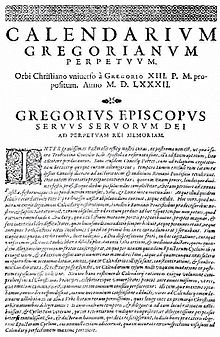Inter gravissimas

With the Bull Inter gravissimas of February 24, 1582 , Pope Gregory XIII decreed . the Gregorian calendar named after him . Like all papal bulls, this one is also quoted according to its initial Latin words ( incipit ), which are translated here: "Among the most important (tasks of our pastoral ministry ...)". You point out that the Council of Trent left the reform of the breviary to the Pope, among other things . In addition to tasks that had already been completed, this included the annual determination of the Easter festival date and the holidays associated with Easter ( Ash Wednesday to Pentecost octave ), whereby the Easter date was to be calculated on an astronomical basis.
The problem
To calculate Easter three things have to be clear: the exact date of the beginning of spring, the determination of the spring full moon and finally the determination of the following Sunday, on which Easter is to be celebrated. The Council of Nicaea had fixed the liturgical beginning of spring on March 21st - then correctly. However, due to the inaccuracy of the Julian calendar , the astronomical spring equinox came ten days earlier.
preparation
The calendar reform had already been tackled by various popes, but the approaches discussed so far either had not been able to offer lasting solutions or had not been compatible with the old ecclesiastical usage. The procedure now developed by Aloisius Lilius and brought to the attention of the Pope by his brother Antonius works with a new cycle of epacts , which takes into account the true solar year and can apply for all times. The Pope sent this model to the most important princes of Christianity and to the great universities, who answered in the affirmative. Gregor commissioned experts from different countries with the final elaboration, based on Lilius' model and supplemented it slightly.
arrangement
The bull decreed that ten days (October 5 through October 14, 1582) should be omitted and that the day following October 4 should be counted as October 15, 1582. On this and the following days, several saints' festivals were to be celebrated, but after October 17th everything was back to normal. In this way, the spring equinox would fall again on March 21 in 1583.
In order to keep the calendar stable, the bull stipulated that, as before, a leap year should be held every four years , including in the year 1600, but then only the last of the four following secular years (1700, 1800 and 1900 not, but 2000 again, and so on).
From 1583, the actual determination of the Easter date should no longer be based on the golden number , but on the newly introduced cycle of epacts based on the golden number. Since the sequence of days of the week was retained, Thursday, October 4th, and October 15th following, fell on a Friday, not a Monday. This was accompanied by the fact that the Sunday letter changed from G to C.
pressure
The new calendar was to be printed and published in Rome together with the adapted martyrology and came into force on October 15, 1582. To ensure the correctness of the text of the order, Antonius Lilius (not named in the text) initially received a printing privilege with the usual sanctions . Foreign printers should comply with the papal license. Since Lilius could not satisfy the demand, however, the sole right of exploitation in the Papal States was withdrawn from him.
distribution
The bull obliged all spiritual officials and all Christians to use the new calendar from the ten days to be skipped under threat of the usual punishments. Emperor Rudolf II , the other kings, princes and cities were asked and commissioned to introduce the calendar among their subjects in order to maintain Christian unity.
Detailed provisions
Deadlines for monthly or annual payments that would be affected by the elimination of the ten days should be able to be extended by ten days in the event of a legal dispute.
introduction
The Gregorian calendar was introduced immediately in Catholic countries and only gradually in Protestant and Orthodox countries .
